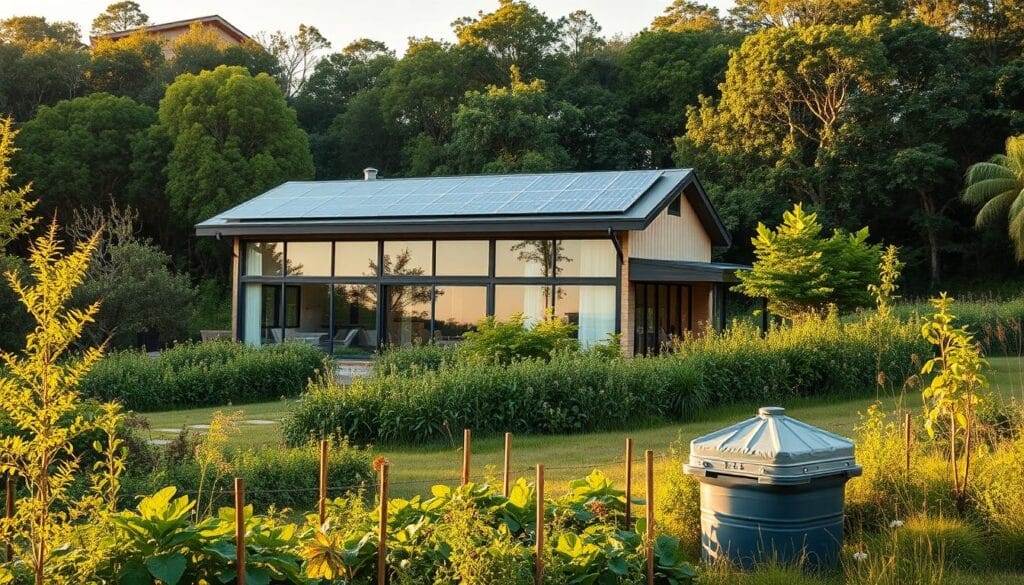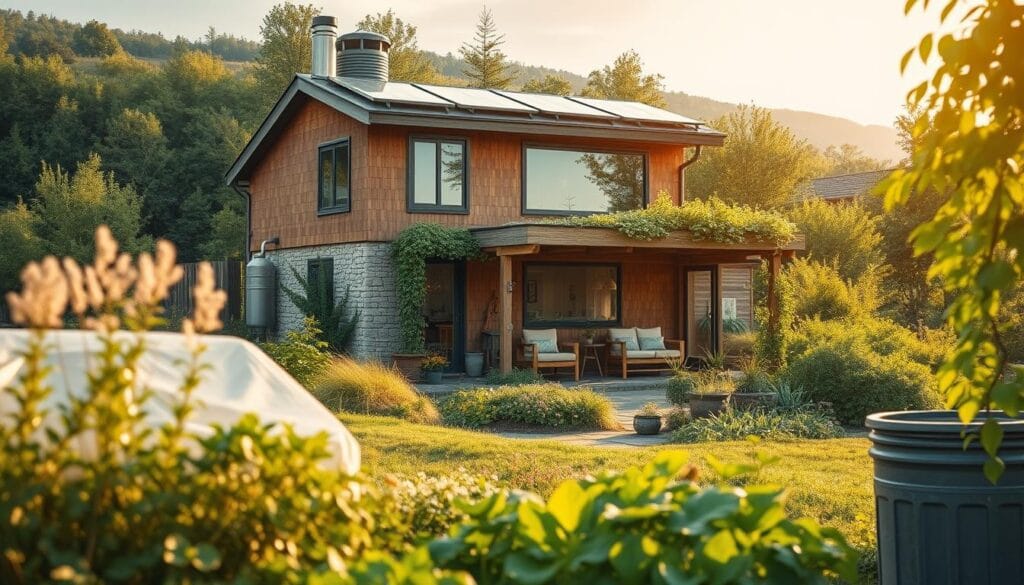Have you ever looked at your utility bill and wondered where all that power is going? You’re not alone. Many of us feel the pinch of rising costs, but the good news is, there’s a way to take control. By making a few thoughtful changes, you can transform your home into a more efficient space—and keep more money in your pocket.
We’re here to guide you through simple, actionable steps that make a big difference. From switching to LED bulbs to managing your thermostat, every small adjustment adds up. Think of it as a journey—one where you’ll not only save on bills but also contribute to a healthier planet.
Let’s dive in together and explore how you can make your home work smarter for you. With expert advice and real-life examples, we’ll show you the way to a brighter, more efficient future.
Understanding Energy Efficiency in Daily Life
Curious how to make your home work smarter for you? It all starts with understanding energy efficiency. Simply put, it’s about using less home energy to achieve the same results. Think of it as doing more with less—saving you money while reducing unnecessary waste.
What is Energy Efficiency?
Energy efficiency means optimizing how you use power in your home. For example, upgrading to LED bulbs can cut energy use by 75% compared to traditional bulbs. Smart power strips can also stop phantom loads, saving you up to 10% on your bill. These small changes add up, making your home more efficient and cost-effective.
Why It Matters for Your Home
Improving home energy efficiency isn’t just about saving money. It’s about making informed decisions that benefit your budget and the planet. By reducing waste, you’re not only lowering your bills but also contributing to a healthier environment. Start with one tip today—like switching to LED bulbs—and see the difference it makes.
Energy-Efficient Living: Smart Tips to Reduce Waste and Save Money
Ever thought about how small changes at home could lead to big savings? By focusing on both your wallet and the planet, you can make a real difference. Let’s explore how reducing energy waste benefits you and the environment.
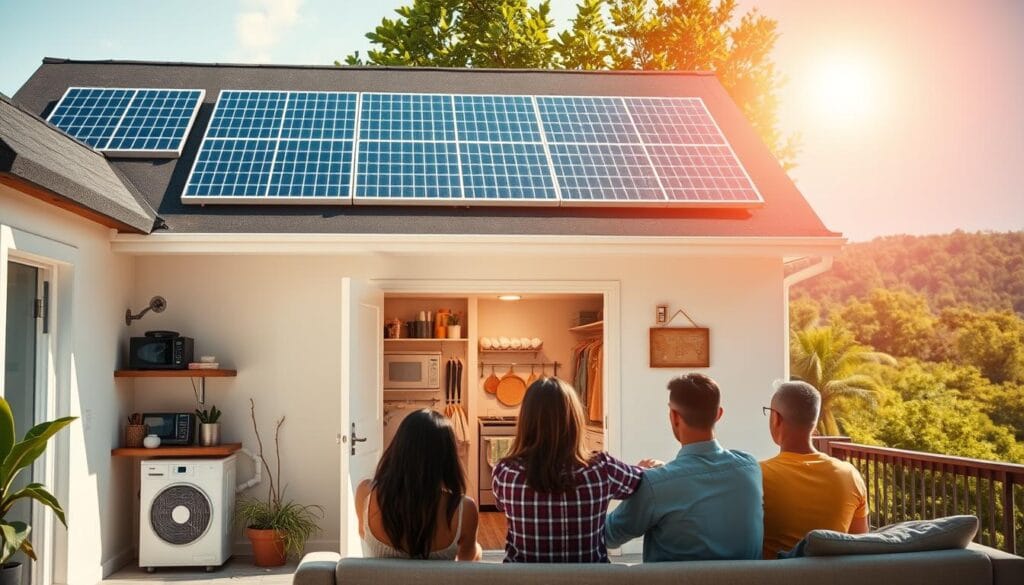
When you cut down on unnecessary energy use, you’re not just lowering your electricity bill. You’re also reducing carbon emissions. It’s a win-win for your budget and the planet. Simple actions, like adjusting your thermostat or upgrading to efficient appliances, can have a big impact.
For example, using a smart thermostat can save you up to 8% on heating and cooling costs. LED bulbs use 90% less energy than traditional ones. These changes address your energy need while keeping your bill in check.
Studies show that small behavioral adjustments can lead to significant savings. Unplugging unused devices can save 5-10% on your electricity costs. Washing clothes in cold water can save around $115 annually. These habits add up over time.
By focusing on sustainability and cost reduction, you’re making choices that benefit both your home and the environment. Ready to learn more? Let’s dive into practical steps you can take today.
Smart Lighting and Power-Saving Strategies
Lighting up your home doesn’t have to drain your wallet. With a few thoughtful upgrades, you can enjoy bright, efficient lighting while keeping your energy bill in check. Let’s explore how smart choices in lighting and power management can make a big difference.
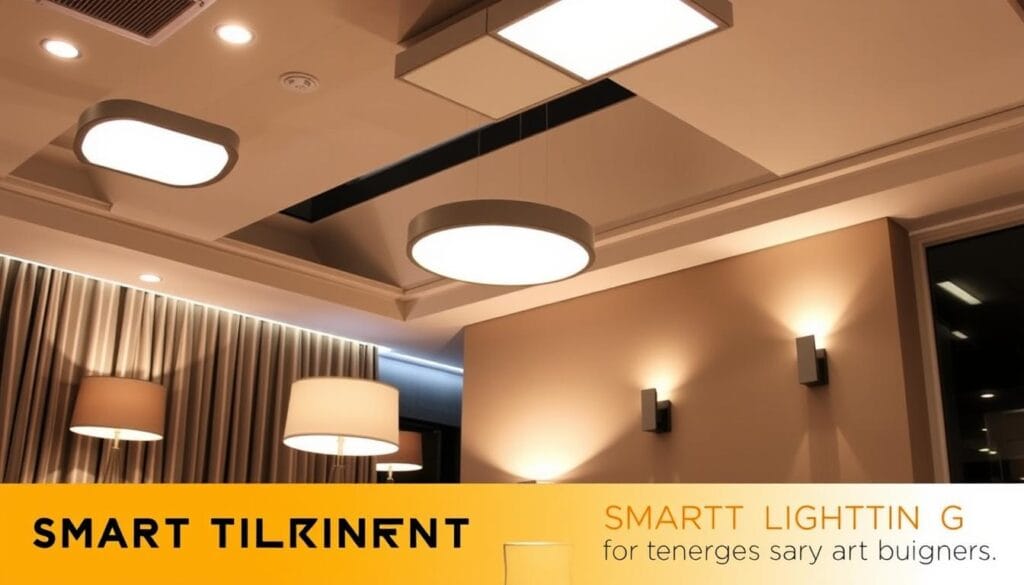
Switching to LED and Energy Star Bulbs
One of the easiest ways to cut energy use is by switching to LED bulbs. These bulbs use up to 90% less energy than traditional incandescent ones. Plus, they last much longer, saving you money on replacements.
Energy Star-certified bulbs are another great option. They meet strict efficiency guidelines, ensuring you get the most out of every watt. Whether it’s for your living room or kitchen, these bulbs provide bright, consistent light without the high cost.
Utilizing Smart Power Strips to Combat Phantom Loads
Did you know your electronics can still draw power even when they’re turned off? This is called a phantom load, and it can add up over time. Smart power strips are designed to eliminate this waste by cutting power to devices when they’re not in use.
For example, your TV, gaming console, and chargers don’t need to stay powered all day. A smart power strip can automatically shut them down, saving you up to 10% on your energy bill. It’s a simple change with a big impact.
By adopting these strategies, you’re not just saving money—you’re also reducing your home’s energy footprint. Start with these steps today and see the difference they make!
Optimizing Heating and Cooling for Cost Savings
Your thermostat settings might be the key to lowering your energy bills. By making a few adjustments, you can improve your home’s efficiency and keep more money in your pocket. Let’s explore how small changes can lead to big savings.
Setting the Right Thermostat Temperatures
Did you know that adjusting your thermostat by just a few degrees can make a difference? In summer, setting it to 78°F can reduce cooling costs. In winter, 68°F is ideal for heating. These small tweaks can save you up to 10% annually.
Programmable thermostats take this a step further. They automatically adjust temperatures based on your schedule, ensuring you’re not wasting energy when you’re away. It’s a simple way to improve efficiency without sacrificing comfort.
Maintenance Tips for HVAC Efficiency
Regular maintenance is essential for keeping your HVAC system running smoothly. Start by replacing air filters every three months. This simple step can improve airflow and reduce energy costs.
Cleaning vents and ducts also helps. Over time, dust and debris can block airflow, making your system work harder. A professional tune-up twice a year ensures your system operates at peak efficiency.
| Task | Frequency | Impact |
|---|---|---|
| Replace Air Filters | Every 3 Months | Improves airflow, reduces energy use |
| Clean Vents and Ducts | Annually | Prevents blockages, enhances efficiency |
| Professional Tune-Up | Twice a Year | Ensures optimal performance |
By following these steps, you’ll not only save money but also extend the life of your HVAC system. It’s a win-win for your wallet and your home.
Reducing Energy Consumption with Appliances
Did you know your appliances could be costing you more than they should? From your dishwasher to your laundry machine, these everyday items can be major energy hogs. But with a few smart choices, you can make them work better for your wallet and the planet.
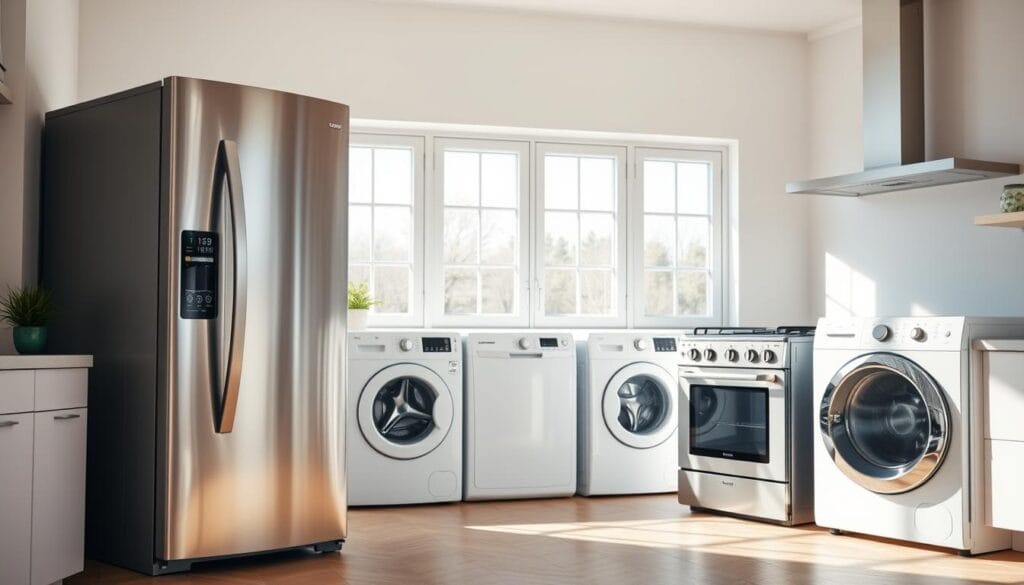
Choosing ENERGY STAR Certified Appliances
When it’s time to upgrade, look for the ENERGY STAR label. These appliances meet strict energy efficiency guidelines, meaning they use less power without sacrificing performance. For example, an ENERGY STAR refrigerator can save you over $220 in its lifetime compared to a standard model.
Modern technology has made these appliances smarter, too. Many come with features like energy-saving modes and smart sensors that adjust usage based on need. It’s a simple way to cut costs while staying eco-friendly.
Efficient Use of Dishwashers and Laundry Machines
Your dishwasher and laundry machine don’t have to drain your energy bill. Start by running full loads—this maximizes efficiency and reduces the number of cycles. Washing clothes in cold water can save around $115 annually, and it’s gentler on fabrics too.
For dishwashers, skip the pre-rinse and use the eco-setting. These small changes can add up to big savings over time. As the saying goes,
“Every drop in the bucket counts.”
By making these adjustments today, you’re not just saving money—you’re also contributing to a more sustainable future. Start small, and watch the benefits grow!
Behavioral Adjustments for Everyday Energy Savings
What if small changes in your daily routine could make a big difference? It’s easier than you think. By tweaking a few habits, you can lower your energy use and shrink your carbon footprint. Let’s explore how simple actions can lead to meaningful savings.
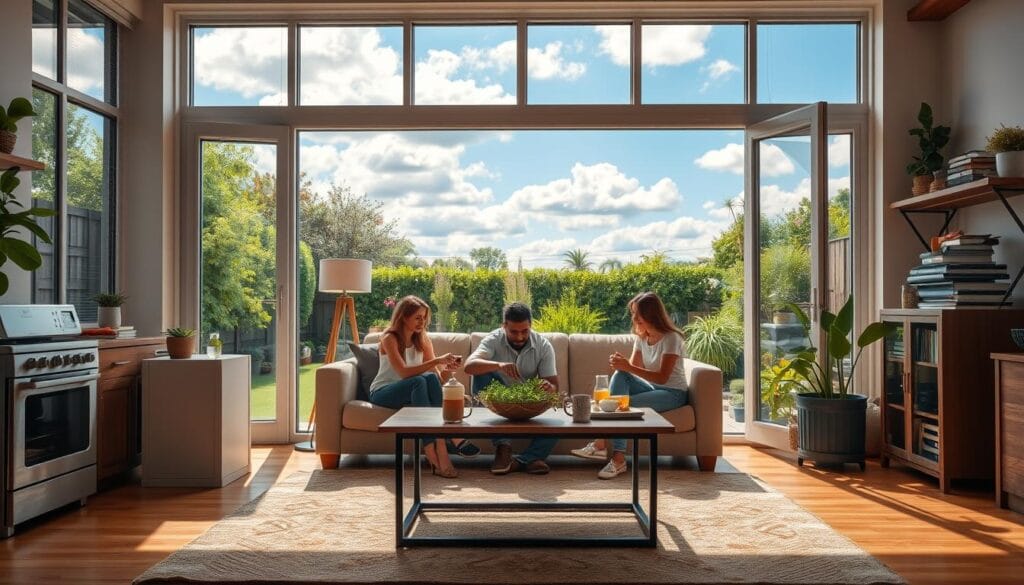
Simple Habits to Reduce Energy Waste
Start with the basics. Turn off lights when you leave a room. Unplug devices that aren’t in use. These small steps can cut your energy waste significantly. For example, leaving electronics plugged in can account for 5-10% of your power bill. A smart power strip can help eliminate this hidden cost.
Adjusting your indoor attire can also make a difference. In winter, wear a cozy sweater instead of cranking up the heat. In summer, opt for lighter clothing and use fans to stay cool. These changes not only save energy but also keep your home comfortable.
Natural light is your friend. Open curtains during the day to brighten your space without flipping a switch. It’s a simple way to reduce electricity use and enjoy a sunlit home. Plus, it’s free!
“Every small action adds up. Over time, these habits can lead to significant savings and a healthier planet.”
Another easy tip? Wash clothes in cold water. This can save around $115 annually and is gentler on fabrics. Run dishwashers only when full, and skip the pre-rinse. These adjustments address your energy needs while keeping your bill in check.
By adopting these habits, you’re not just saving money—you’re also reducing your household’s carbon footprint. It’s a win-win for your wallet and the environment. Ready to make a change? Start today and see the difference!
For more ideas on cutting energy use, check out these easy ways to save energy at.
Upgrading Home Insulation and Weatherization
Ever wondered why your home feels drafty despite your heating cooling system working overtime? The answer might lie in gaps and poor insulation. By weatherizing your home, you can prevent energy loss and make your space more comfortable and cost-effective.

Sealing Doors, Windows, and Gaps
Small cracks around doors and windows can let in drafts, forcing your system to work harder. Sealing these gaps with caulk or weather stripping can make a big difference. For example, air leaks can account for up to 25% of energy loss in a home.
Installing energy-efficient windows is another smart move. They reduce heating cooling needs by 10-20%, saving you up to $500 annually. It’s a simple upgrade with long-term benefits.
Maximizing Insulation in Key Areas
Your attic, walls, and basement are key areas where insulation matters most. Upgrading insulation here can cut energy use by 10-15%. For instance, attic insulation alone can save you around $200 per year.
Spray foam insulation is a great option. It lasts over 30 years and can reduce energy costs by 20-50% compared to traditional materials. It’s an investment that pays for itself in just a few years.
| Weatherization Task | Annual Savings | Impact |
|---|---|---|
| Sealing Air Leaks | $200 – $400 | Reduces drafts, improves comfort |
| Upgrading Attic Insulation | $200 | Cuts energy use by 10-15% |
| Installing Energy-Efficient Windows | $100 – $500 | Lowers heating cooling needs |
By weatherizing your home, you’re not just saving on fuel costs—you’re also reducing your carbon footprint. Start with an inspection today and take steps toward a more efficient, comfortable home.
Harnessing Smart Home Technology
Imagine a home that adapts to your needs while cutting energy costs effortlessly. With smart home technology, this vision becomes a reality. These innovative tools not only simplify your life but also help you manage energy use more effectively. Let’s explore how you can make your home smarter and more efficient.
Programmable Thermostats and Energy Monitors
Programmable thermostats like Google Nest and Ecobee are game-changers. They adjust temperatures automatically based on your schedule, saving up to 10-15% on heating and cooling bills. Imagine coming home to the perfect temperature without lifting a finger.
Energy monitors take things a step further. They track your energy usage in real-time, helping you identify areas where you can cut back. By understanding your energy footprint, you can make informed decisions that lead to significant savings.
Smart Lighting and Window Control
Smart lighting systems are another powerful tool. They allow you to control light levels remotely and even adjust them based on natural daylight. This can reduce energy consumption by up to 30% compared to traditional lighting.
Smart shades and window treatments also play a role. They optimize natural light and heat gain, cutting heating and cooling costs by up to 20%. It’s a simple way to enhance comfort while saving energy.
By embracing these technologies, you’re not just making a change—you’re creating a more efficient, comfortable home. Ready to take the next step? Start exploring smart home solutions today and see the difference they can make!
Innovative Renovations for Energy-Efficient Windows
Windows are more than just a view to the outside—they can transform your home’s comfort and efficiency. By upgrading to double-pane or low-E coated windows, you can reduce energy consumption and keep your home comfortable year-round. Let’s explore how these innovative solutions work and why they’re worth the investment.
Benefits of Double-Pane and Low-E Coated Windows
Double-pane windows are designed with two layers of glass, creating an insulating barrier. This reduces heat transfer, keeping your home cooler in summer and warmer in winter. Low-E (low emissivity) coatings add another layer of protection by reflecting infrared light, further minimizing thermal loss.
In colder area climates, these windows prevent heat from escaping, reducing your heating needs. In warmer regions, they block excess heat from entering, lowering cooling costs. The result? A more comfortable home and lower utility bills.
According to studies, upgrading to double-pane or low-E coated windows can cut energy consumption by up to 25%. This translates to significant savings over time, making them a smart choice for any homeowner.
| Window Type | Energy Savings | Climate Impact |
|---|---|---|
| Double-Pane | 15-25% | Reduces heat loss in winter |
| Low-E Coated | 20-30% | Blocks heat gain in summer |
Maintenance is simple—regular cleaning and occasional inspections ensure your windows perform at their best. For a stylish upgrade, consider adding window treatments like thermal curtains or blinds. These not only enhance your home’s aesthetic but also boost energy efficiency.
Ready to make a change? Start by evaluating your current windows and exploring upgrade options. With the right choices, you can create a more sustainable, comfortable home while keeping your utility costs in check.
Seasonal Tips for Energy Efficiency Across Your Home
Seasonal changes bring unique opportunities to enhance your home’s efficiency. By making small adjustments, you can optimize your energy use and keep your home comfortable year-round. Let’s explore how to tackle summer heat and winter chill with practical, actionable steps.
Summer Cooling Strategies
Summer heat can drive up your cooling costs, but there are ways to stay cool without breaking the bank. Start by closing blinds or curtains during the day to block out the sun’s heat. This simple step can reduce indoor temperatures significantly.
Use natural ventilation whenever possible. Open windows in the early morning or late evening to let in cooler air. Ceiling fans are another great tool—they create a wind chill effect, making you feel cooler without lowering the thermostat.
Smart shading devices, like awnings or reflective window films, can also help. They block heat from entering your home, reducing the need for air conditioning. For more ideas on creating a functional and stylish space, check out these must-have features for your home.
Winter Heating Best Practices
Winter brings its own challenges, but with the right strategies, you can stay warm and save energy. Start by setting your thermostat to 68°F during the day and lower it at night or when you’re away. This step can save up to 10% on heating bills.
Proper insulation is key. Seal gaps around doors and windows to prevent drafts. Adding weather stripping or caulk is an easy, cost-effective fix. Don’t forget to insulate your attic and walls—this can cut energy loss by up to 15%.
Dress warmly indoors to reduce reliance on your heating system. Layering up with sweaters and using cozy blankets can make a big difference. Area rugs also help by insulating floors and keeping rooms warmer.
By taking these seasonal steps, you’re not just saving money—you’re also making your home more energy efficient. Every small change adds up, helping you reduce energy use and create a more sustainable living space.
Conclusion
Making your home more efficient doesn’t have to be overwhelming. Every choice you make—from switching to an LED bulb to sealing gaps around your door—adds up to meaningful savings. These small steps not only lower your bills but also reduce your environmental impact.
For example, adjusting your thermostat by just a few degrees can save up to 10% annually. Upgrading to energy-efficient appliances can cut costs even further. Each door you open toward efficiency is a step toward a brighter, more sustainable future.
Start today with one simple change. Over time, these adjustments will lead to significant savings and a more comfortable home. Embrace the power of thoughtful choices and see the difference they can make!

